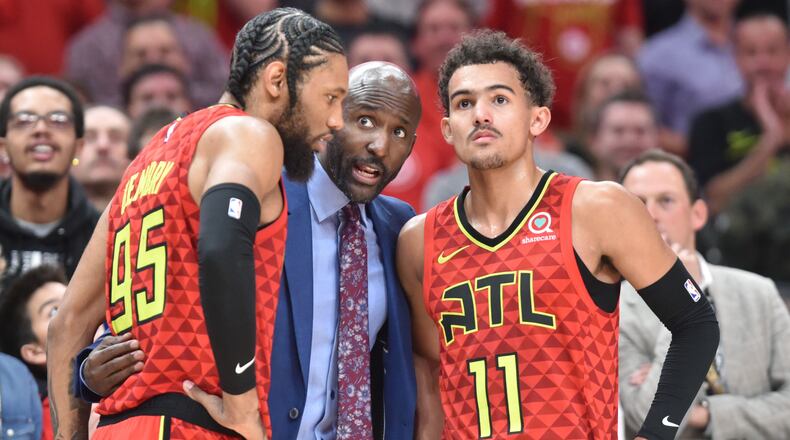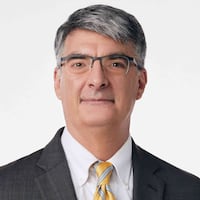Lloyd Pierce had a defensive philosophy developed during five seasons as an assistant coach with the 76ers.
He scrapped it when he became head coach of the Hawks. In fact, his system hasn’t been installed fully yet, even now after his first full season as a head coach.
Why?
“Anyone’s system is based on who you have and what you have to do,” Pierce said in an exclusive interview with The Atlanta Journal-Constitution.
Pierce described his system in Philadelphia, where he served as the defensive coordinator, as “finish over length.” You see with a lineup that included a 6-foot-10 point guard in Ben Simmons, a 6-3 shooting guard in J.J. Redick, a 6-9 small forward in Robert Covington, a 6-10 power forward power forward in Dario Saric and a 7-2 center in Joel Embiid, there were options. The 76ers had the luxury of switching on defense as each player presented an issue for the opposition because of his length. Make them shoot over you – and good luck with that.
Hawks personnel didn’t allow for such an option. No such length to try to finish over.
So Pierce came up with a new plan and a new mantra. He has dubbed it “prevention and protection.” First, don’t allow penetration into the restricted area and, if you do, make the necessary adjustment to protect at the rim.
“Let’s prevent any of these things from happening – containment, showing a crowd,” Pierce said. “Let’s prevent. If for some reason we can’t prevent, let’s make sure we can protect. Let’s bring that defender over. Let’s rotate on any skip pass. Let’s rotate. Those things take time because prevention is something you’ve got to focus on. You put all your eggs in this basket, which is prevention.
“I want to sell it to our guys. I want to be bravo and macho about it. Then you become realistic. We are not going to contain all the penetration. So we have to be just as good at protection as we are at prevention.”
This commitment to defense must be consistent play-by-play, possession-by-possession. That takes time – and video work. Lots of video work. It takes showing blow-bys over and over. It takes showing the failure of a weakside defender to offer protection. It takes the willingness to leave a shooter to prevent a drive to the basket knowing someone else will rotate and help your void.
Pierce singled out DeAndre Bembry, who finally played a healthy season, as a defender who could be the initial prevention defender without much help.
“In a nutshell, it’s hard because we don’t have the luxury right now to say finish over length,” Pierce said. “We have to protect everyone with rotations, with crowds, with positioning. That takes time. It takes trust. It’s not even a scheme thing. It’s a principle thing. We haven’t even got to schemes yet because our principles need to be better. It takes 2-3 years for you to become really good defensively, and a lot of it goes back to prevention. Elite teams prevent. Championship teams prevent and protect.”
General manager Travis Schlenk related a story regarding the Hawks’ defensive growth through the season. At the start of the season, if the Hawks switched a pick-and-roll, a bigger opponent would often back point guard Trae Young into the post. By the end of the season, Young was getting help from a weakside wing to neutralize the threat.
“Those small things that just take time for a young basketball team and young players to figure out are going to help our defensive numbers in general,” Schlenk said.
The Hawks struggled on defense much of last season. They finished allowing a league-high 118.3 points per game. They were 26th in opponents field-goal percentage (47.3) and defensive rating (113.0) and 27th in opponents field goals made (42.4).
Pierce said he uses effective field-goal percentage defense has a barometer for his defense. The Hawks ranked 27th in the league this season at 54.1 percent. Blocks and steals are nice, but he looks at the volume of shots at the rim. Is the opponent taking the shots the Hawks want and are they making those shots difficult? Next comes cutting down easy baskets – transition, free throws second-chance. Pierce said he was generally pleased with the transition defense, not-so-pleased with the number of fouls committed and is working on the deflating nature of second-chance points. Nothing is worse, he says, then playing good defense only to allow a rebound and a kick-out 3-pointer.
“It’s important to be really good and trust what you do and get better at what you do before (installing a full defense),” Pierce said. “We are still at prevention and protection. We have coverages. We don’t really have elaborate schemes because I don’t think we are ready for it.”
There are defensive coverages. Pierce gets a small smile on his face with the describes his plan to defend Embiid.
“Joel Embiid is on the block, I’ve got about seven different coverages I can throw at him,” Pierce said. “And he knows it, too. He hates playing us because he knows he’s not going to have a fun day. He’s going to have to work for his. Just because he knows there are a lot of different coverages, and he doesn’t know which one. We can blitz from the top. We can blitz on the dribble. We can blitz from the baseline. We can blitz off the cutter. We can send the opposite big. There are a lot of different ways.”
The schemes will come later – with more growth and development of his young team. Add those to a solid foundation of prevention and protection principles and the Hawks will be on their way. Pierce will know when he hears his players talking on defense on a consistent basis. Teams don’t talk if they are unsure of the defense, their role or their responsibility.
Then Pierce will fully install his defense.
“We got a lot of stuff in our back pocket,” he said.
About the Author
Keep Reading
The Latest
Featured



